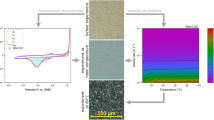Abstract
A computational model is presented, which enables the identification of those zones endangered by corrosion in a bipolar electrolysis cell stack. The method consists of two steps: first the potential profile in the electrolyser is computed by numerical solution of the Laplace equation using the finite difference method; then, making use of the Criss-Cobble correspondence principle, this profile is related to the potential-dependent thermodynamic stabilities of the respective metals. This may be a useful tool in the design of intermittently operating electrolysers (for example those powered by solar energy).
Similar content being viewed by others
Abbreviations
- A :
-
metal phase
- A i :
-
single A-phase point
- B :
-
electrolyte phase
- B i :
-
single B-phase point
- F :
-
Faraday constant
- h :
-
mesh interval (m)
- i :
-
local current density (A m−2)
- i 0 :
-
exchange current density (A m−2)
- j :
-
local current across the double layer (A)
- j iA,j iB :
-
tangential or normal component of the double layer current (A)
- K :
-
A, B phase conductivity ratio
- m :
-
molality mol kg−1
- R :
-
gas constant
- T :
-
absolute temperature (K)
- U :
-
potential (V)
- U 0 :
-
water decomposition voltage (V)
- U tot :
-
end plate potential (V)
- x, y :
-
cartesian coordinates
- α:
-
overrelaxation factor
- ηa, ηc :
-
anodic or cathodic overpotential (V)
- κA, κB :
-
electrical conductivity (Ω−1 m−1)
- Φ:
-
potential (V)
- Φm :
-
local double layer potential, electrode end (V)
- Φs :
-
local double layer potential, electrolyte end (V)
References
M. Jaksic,Electrochim. Acta 29 (1984) 1539.
J. Divisek and J. Balej, to be published in DECHEMA-Monographien 1990.
J. Divisek and H. Schmitz, ‘Galvanische Herstellung und elektrochemische Stabilität von aktiven Nickelelektroden’, DECHEMA-Monográphie, 1989, p. 299.
L. Lapidus and G. F. Pinder, ‘Numerical Solution of Partial Differential Equations in Science and Engineering’, Wiley, New York (1982) pp. 34–48.
D. Britz, ‘Digital Simulation in Electrochemistry’, 1st edn, Springer, Berlin (1980).
C. J. H. King and D. E. Danley, ‘Experimental Measurement of Current Leakage in a Commercial Scale Bipolar Cell Stack’, The Electrochemical Society Extended Abstracts, May 1982. (Cited in [7]).
J. W. Holmes and R. E. White, in ‘Electrochemical Cell Design’ (Ed. R. E. White), Plenum, New York (1984) p. 311.
E. C. Dimpault-Darcy and R. E. White,J. Electrochem. Soc. 135 (1988) 656.
I. Rousar, K. Micka and A. Kimla, ‘Electrochemical Engineering’, Elsevier, Amsterdam (1986).
J. Divisek, J. Mergel and H. Schmitz, ‘Advanced water electrolysis cell in discontinuous operation mode’, in Hydrogen Energy Progress VII edited by T. N. Veziroglu and A. N. Protsenko, Pergamon, Oxford (1988) p. 327.
J. Divisek and L. Fürst, ‘Ermittlung des Potentialprofils in einem bipolaren Elektrolyseur’, DECHEMA-Monographie 1989, p. 245.
T. V. Nguyen and R. E. White,Comput. Chem. Engng. 11 (1987) 543.
H. S. Burney and R. E. White,J. Electrochem. Soc. 135 (1988) 1609.
C. M. Criss and J. W. Cobble,J. Am. Chem. Soc. 86 (1964) 5385.
Idem, ibid. 86 (1964) 5390.
Author information
Authors and Affiliations
Rights and permissions
About this article
Cite this article
Divisek, J., Jung, R. & Britz, D. Potential distribution and electrode stability in a bipolar electrolysis cell. J Appl Electrochem 20, 186–195 (1990). https://doi.org/10.1007/BF01033594
Received:
Revised:
Issue Date:
DOI: https://doi.org/10.1007/BF01033594




